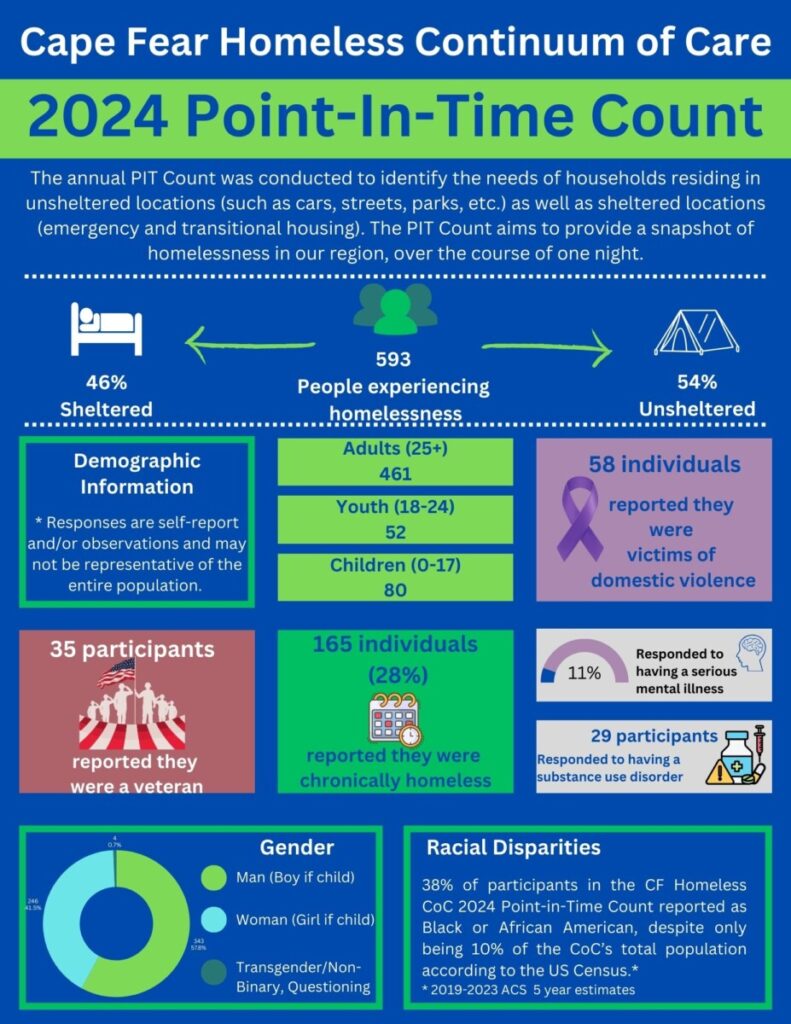Racial Equity Data Analysis Summary of Report
In the Summer and Fall of 2022, and in partnership with NC HMIS and C4 Innovations, we participated in an initiative to conduct a racial equity system analysis. C4 used disaggregated quantitative data pulled from the HUD Stella Performance Module for the CoCs involved in the analysis. Also known as "Stella P", the HUD visualization platform disaggregates system-level data by race and ethnicity. We provided C4 with "Stella P" data over four years, 2018, 2019, 2020 and 2021. The data has limitations including that fact that data is not provided at a program level, does not include street outreach data or CES data, and does not provide intersectionality between age and gender. C4 conducted the analysis, including:
- System-wide general demographic data
- Rates of households in Emergency Shelter/Safe Havens/Transitional Housing, Rapid Rehousing (RRH) and Permanent Supportive Housing (PSH)
- Exits to permanent housing, temporary destinations, and unknown destinations
- Returns to homelessness
- Length of time homeless
Analyzing disaggregated data by race and ethnicity is a first step in identifying, understanding, and addressing racial inequities in our community. Gathering quantitative and qualitative data will help you begin to understand the ways in which Black, Brown, Indigenous, and People of Color experience homelessness and housing insecurity outcomes differently than white households in our CoC.
The resulting report highlights several inequities identified in the analysis that may provide a starting point for community conversations and further exploration. It also provides recommendations on how to interpret the data and build context to better understand these trends/patterns. Neither C4 nor NC HMIS imply that the potential inequities should necessarily be priority areas for the CoC, rather it provides them as examples. The examples are meant to increase awareness about racial and ethnic disparities in the homeless response system and encourage capacity building within the community to integrate racial equity practices into their system planning on an ongoing basis.
Using Census data as a basis for comparison, the overall racial and ethnic population distributions to our 2021 PIT count data, the greatest disparities exist among households identifying as Black, Native American/Alaskan, and Other/Multiracial:
- Households identifying as Black accounted for 35% of the 2021 PIT count and only 13% of the general population in our regional CoC. This means that Black households are 2.7 times more likely to be represented in the PIT count as experiencing homelessness when compared to Census demographics.
- Households identifying as Native American/Alaskan accounted for 1% of the 2021 PIT count and only 0.4% of the general population. This means that Native American/Alaskan households are 5 times more likely to be represented in the PIT count as experiencing homelessness when compared to Census demographics.
- Households identifying as Other/Multi-Racial accounted for 5% of the 2021 PIT count and only 4% of the general population, meaning that Other/Multi-Racial households are 1.3 times more likely to be represented in the PIT count as experiencing homelessness when compared to Census demographics.
Racial Disparities in Rates of Connection to Resources
Across all four years of data examined for NC 506, households identifying as White, Non-Hispanic/Non-Latino were connected to Permanent Supportive Housing (PSH) at higher rates than to Rapid Rehousing (RRH). For example, in 2020, 67% of households that were connected to PSH identified as White, Non-Hispanic/Non-Latino, compared to 21% of households identifying as Black or African American. This trend continued in 2021, where 66% of households connected to PSH identified as White, Non-Hispanic/Non-Latino, and 21% identified as Black or African American.
Disparities in Length of Time Homeless
Households identifying as Native/Indigenous, Multiracial, and Black or African American are disproportionately represented in homelessness when comparing the PIT count to the rates of each group in the general population. These groups experienced an overall increase in the average number of days spent unhoused across 2018, 2019 and 2020. For example, the average length of time that households identifying as Black or African American spent unhoused (in programs, not including self-reported data) increased from 74 days in 2018, to 85 days in 2019, to 102 days in 2020. American Indian or Alaska Native households' average length of time spent unhoused (in both programs and via self-reported data) increased from 354 days in 2018, to 569 days in 2019, to 5,167 days in 2020, but as the number of individuals in this group are small, the sample size likely contributed to the large increase so an opportunity for further exploration may be to compare the actual numbers of individuals in each group alongside the average.
Next Steps
Again, examining data disaggregated by race and ethnicity in "Stella P" is a first step towards questioning inequities and creating a more racially equitable homeless response system. It is incumbent upon our CoC to use HMIS and other data to more deeply consider any patterns that emerge in disaggregated system-level data. It may also be useful to identify the root causes of racial and ethnic inequities to understand why there are disparities among Black, Brown, Indigenous, and People of Color experiencing homelessness. There are many aspects of the homeless response system, other than a household’s initial access to the system, to consider as we move forward.
Further, there are opportunities to consider the geography and locations of households becoming unhoused in the CoC. Taking into account the location of access points as they relate to the neighborhoods where households are becoming homeless may help give more context to the trends identified.
Another way to give data context is to consider the location of grassroots or other service organizations that are not officially affiliated with the CoC, but serve populations disproportionately impacted by homelessness. Developing new partnerships with these organizations may strengthen the CoC’s response to reducing racial and ethnic inequities and maximize access of those most impacted by homelessness to available housing resources and services. The Stella dashboard includes a map of all counties in North Carolina on top of demographic data from the Census. This tool may help us to consider where different demographic groups are located generally, and what additional analysis of location data may be able to tell us.
Again, the report is not intended to be comprehensive but a first step, using a snapshot of our data to move our CoC forward in considering racial equity in the systems that support community members experiencing homelessness.


